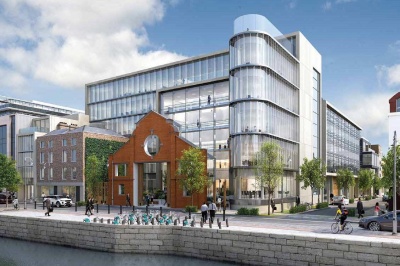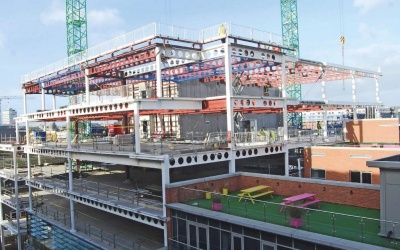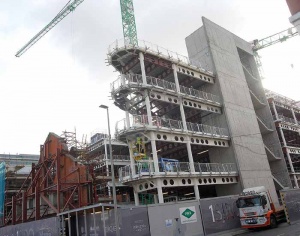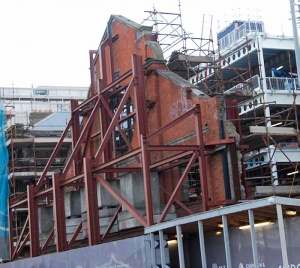1-6 Sir John Rogerson's Quay, Dublin
Article in NSC February 2018
Riverside development
Overlooking the River Liffey, Dublin’s latest prestigious commercial scheme is a highly-engineered steel-framed project incorporating two historic structures.
By Martin Cooper
After a number of years in the doldrums, the construction sector in the Republic of Ireland is showing signs of an upturn and Dublin’s skyline is once again awash with tower cranes. One of the most prestigious schemes currently being undertaken is the 1-6 Sir John Rogerson’s Quay project. Situated on the south bank of the River Liffey, a few hundred metres from the city centre, the project forms an important element in the regeneration of an area once dominated by dockside warehouses.
The main part of the project consists of a steel-framed six-storey office building with ground floor retail units and a large basement containing car parking and bicycle storage facilities. The building will offer approximately 10,200m2 of commercial floor space and 500m2 of ground floor retail space, all housed within a building featuring long clear spans and only two internal columns.
“This is a modern prestigious inner city development and choosing a steel-framed solution was the easiest way of creating the desired open-plan design,” explains John Paul Construction Project Manager Eddie Cogan. With one centrally positioned concrete core, the steel frame radiates outwards with maximum clear spans of up to 15m being achieved on three sides. The exception is the southern rear elevation where, due to the length of the spans, the structure’s only two internal columns have been installed creating two spans of 11m and 8m respectively.
Cellular beams, measuring 740mm-deep and with 500mm holes, have been used throughout the project for a cost-effective method of accommodating the building’s services. The beams support a composite metal deck flooring solution throughout.
“Steelwork was also chosen for its flexibility,” explains Casey O’Rourke Engineer John McMenamin. “Strengthening of the frame has occurred on the fourth and fifth floors where the building has step-backs accommodating outdoor terraces. Here a series of larger than normal 14m-long × 740mm-deep plate girders, each weighing nearly 7t, has been installed to accommodate the extra loadings.”
Kloeckner Westok provided design support throughout the project as Westok’s Design Team Manager John Callanan explains, “In the Dublin commercial office sector, we have certainly seen a shift away from traditional concrete frames to clear span steel-framed cellular beam solutions. It is great to see Irish developers and architects keen to exploit the programme and commercial benefits steelwork brings to the table. At 1-6 Sir John Rogerson’s Quay, we worked closely with the engineer to provide optimised pre-cambered beams, and we also had to meet very stringent deflection tolerances for the edge beams supporting the cladding. We’re pleased Westoks ticked all the boxes”.
Along the front riverside elevation, the development incorporates two retained features, a masonry arched entranceway and a historic building dating back to the 1600s. New steelwork has been used to support the entranceway, but essentially the main steel frame does not touch either of these two existing structures. The entranceway will provide the development with a grand access/exit point and will lead into an open courtyard that in turn leads to the main building entrance lobby.
Perhaps the most stand-out feature of the building is a protruding bullnose wing that overlooks the main northern riverside elevation. Jutting out adjacent the open courtyard, the bullnose is the full height of the building and will offer the lucky occupants some excellent views up and down the Liffey. Faceted welded beams supported on CHS columns form the bullnose point. The feature 356mm-diameter tubular columns then extend along the length of the building’s perimeter elevations. As they will remain exposed within the completed scheme, they create another feature element for the development.
Kiernan Structural Steel (KSS) has erected the entire steel frame using the project’s two tower cranes, with the only exception being three bridges that span across the main entrance lobby at floors three, four and five.
The steel bridges measure 250mm-deep × 1,500mm-wide × 16.5m-long and each one weighs almost 21.5t. Brought to site as complete units, they were too heavy for the tower crane’s capacity and consequently another lifting solution was required. “Due to the ground conditions along the river we were not able to support a mobile crane, which would have been our preferred option,” says KSS Managing Director John Kiernan. “We had to skid the bridges along the ground floor slab and then lift them into position using lifting beams built off the fifth floor steelwork overhead and use a pneumatic heavy duty chain block.”
1-6 Sir John Rogerson’s Quay is due to complete in July 2018.
Retained features
As the address implies, the project was once occupied by six separate buildings, with 1, 2, and 3 demolished to create the space for the main six-storey building.
A 14m-high arched brickwork entrance that once allowed trains to enter the warehouse at number 2 is a listed element that has been retained within the project. This is now a free-standing structure, unconnected to the project’s other structures. In order to make the arched entrance self-supporting, steelwork contractor Kiernan Structural Steel installed 80mm-thick plate girders around the inside of the façade, which were then connected to universal column sections which are set into the piled foundations.
Numbers 4 and 5 form another retained element of the scheme. Dating back to 1680, these buildings once housed the Docker’s Pub, once famous as a haunt of musicians, including U2, when they were recording at the Windmill Lane studios that formerly occupied a site to the rear of the project, and the Merchant Seaman Society. The old four-storey structure is being renovated and could on completion be occupied by restaurants, or alternatively they could be incorporated into the main scheme via a link.
Occupying a slither of land between the retained pub building and an existing structure, number 6 has been knocked down and is being rebuilt as a stepped four-storey steel-framed building that will link into the main building.
| Architect | Henry J. Lyons Architects |
| Structural Engineer | Casey O’Rourke |
| Steelwork Contractor | Kiernan Structural Steel |
| Main Contractor | John Paul Construction |
| Main Client | Hibernia Reit |







